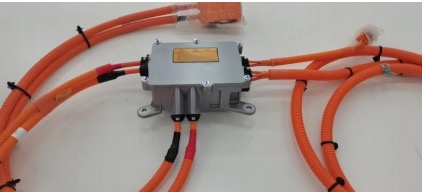How to Evaluate High Voltage Power Distribution Boxes for EV Applications

Electric vehicles (EVs) have revolutionized transportation by using about 47% less energy than gasoline-powered vehicles. This efficiency hinges on effective high voltage power distribution. You play a crucial role in ensuring this efficiency by selecting the right high voltage power distribution box. These boxes manage energy flow, impacting both performance and safety. As you evaluate these components, consider factors like voltage range, material durability, and safety features. Your choices directly influence the vehicle's reliability and energy management, making your role vital in the EV ecosystem.
Understanding High Voltage Power Distribution Boxes
Definition and Functionality
A high voltage power distribution box serves as the central hub for managing electrical energy within an electric vehicle (EV). It ensures that each component receives the appropriate power level, optimizing the vehicle's performance and efficiency. You will find that these boxes play a crucial role in maintaining the overall health of the EV powertrain.
Basic components and their roles
The basic components of a high voltage power distribution box include fuses, relays, and connectors. Fuses protect the system by breaking the circuit in case of overloads, while relays control the flow of electricity to various components. Connectors ensure secure and efficient connections between different parts of the EV system. Each component works together to distribute power effectively, ensuring that critical systems like traction drive, power steering, and brake resistors receive the necessary energy.
Integration into EV systems
Integrating a high voltage power distribution box into an EV system involves connecting it to the battery pack, motor drive inverter, and other high-voltage components. This integration ensures seamless energy flow throughout the vehicle, enhancing its performance and safety. You must consider the compatibility of the distribution box with the EV's architecture to ensure optimal functionality.
Types of High Voltage Power Distribution Boxes
High voltage power distribution boxes come in various types, each designed to meet specific needs and requirements. Understanding these differences will help you choose the right solution for your EV application.
Differences between AC and DC distribution boxes
AC and DC distribution boxes differ primarily in the type of current they handle. AC distribution boxes manage alternating current, which is typically used in charging systems and some auxiliary components. In contrast, DC distribution boxes handle direct current, which powers the main traction system and other critical loads. You should select the appropriate type based on the specific requirements of your EV system.
Custom vs. standard solutions
When choosing a high voltage power distribution box, you have the option of selecting either custom or standard solutions. TE Connectivity offers both standard and customized power distribution box solutions, allowing you to tailor the system to your specific needs. Custom solutions provide flexibility and can enhance performance and safety by addressing unique requirements. However, standard solutions offer reliability and ease of integration, making them suitable for many applications.
Technical Specifications and Requirements
When evaluating a high voltage power distribution box for electric vehicles, you must focus on technical specifications and requirements. These factors significantly influence the performance, safety, and efficiency of the vehicle.
Voltage and Current Ratings
Matching ratings with EV requirements
You need to ensure that the voltage and current ratings of the high voltage power distribution box align with the specific requirements of your EV. Typically, these boxes support a voltage range from 48 VDC to 1000 VDC. This compatibility is crucial for the seamless operation of the vehicle's electrical system. By matching these ratings, you optimize the energy flow, which enhances the overall efficiency of the EV. Studies have shown that improvements in EV efficiencies can reduce electricity consumption per mile, leading to lower electricity demand and consumer energy cost savings.
Impact on performance and safety
The voltage and current ratings directly impact the performance and safety of the EV. A mismatch can lead to inefficient energy distribution, affecting the vehicle's performance. Moreover, incorrect ratings can pose safety risks, such as overheating or electrical failures. Ensuring the right specifications helps maintain the integrity of the vehicle's powertrain and protects both the electronic components and the occupants.
Material and Design Considerations
Thermal management and insulation
The material and design of a high voltage power distribution box play a vital role in thermal management and insulation. Effective heat management is essential to prevent overheating, which can compromise the box's functionality and the vehicle's safety. You should look for designs that incorporate efficient power dissipation features. Proper insulation ensures that the box can handle high voltages without risking electrical faults. This aspect is critical for maintaining the reliability and longevity of the EV's electrical system.
Durability and environmental resistance
Durability and environmental resistance are key considerations when selecting a high voltage power distribution box. The materials used should withstand harsh conditions, such as extreme temperatures, moisture, and vibrations. A durable design ensures that the box can endure the rigors of daily use without degradation. Environmental resistance protects the box from external factors that could affect its performance. By choosing a robust and resilient design, you enhance the vehicle's reliability and ensure consistent energy distribution.
Safety and Compliance Standards
Regulatory Standards for EV Components
When evaluating high voltage power distribution boxes for EV applications, you must consider the regulatory standards that govern these components. These standards ensure that the products meet safety and performance criteria essential for reliable operation.
Overview of relevant standards (e.g., ISO, IEC)
The International Standard ISO 6469 plays a pivotal role in EV safety. It addresses on-board electrical energy storage, functional safety, and protection against electrical hazards. Adhering to this standard ensures rigorous safety testing for EVs. Additionally, the International Electrotechnical Commission (IEC) provides guidelines for electrical equipment, ensuring compatibility and safety across different regions. These standards help maintain a uniform level of safety and performance in EV components worldwide.
Certification processes and requirements
Certification processes validate that the high voltage power distribution boxes comply with these standards. You must ensure that the components undergo thorough testing and certification by recognized bodies. This process involves evaluating the product's design, materials, and functionality to ensure they meet the required safety and performance benchmarks. Certification not only guarantees compliance but also enhances the credibility and reliability of the product in the market.
Safety Features and Testing
Safety features and testing are crucial aspects of evaluating high voltage power distribution boxes. These elements ensure that the components can operate safely under various conditions and protect both the vehicle and its occupants.
Importance of fail-safes and redundancy
Fail-safes and redundancy are vital safety features in high voltage power distribution boxes. They provide backup systems that activate in case of a primary system failure, ensuring continuous operation and preventing catastrophic failures. You should prioritize components with robust fail-safe mechanisms to enhance the overall safety and reliability of the EV.
Common testing procedures and benchmarks
Testing procedures for high voltage power distribution boxes include a series of rigorous assessments to evaluate their performance and safety. Common tests involve thermal management, electrical insulation, and environmental resistance. These tests ensure that the components can withstand extreme conditions and maintain their functionality. Benchmarks set by standards like FMVSS Compliance Standards for EVs and hybrids establish performance requirements, such as addressing electrolyte spillage and isolating high-voltage batteries from low-voltage systems. By adhering to these benchmarks, you can ensure that the power distribution boxes meet the necessary safety and performance criteria.
When evaluating high voltage power distribution boxes for EV applications, focus on key criteria like voltage compatibility, material durability, and safety features. A thorough evaluation ensures both safety and performance, protecting the vehicle and its occupants. Staying updated with evolving standards is crucial. Regulatory standards play a pivotal role in ensuring safety and environmental compliance. They also impact technological evolution by setting guidelines. By adhering to these standards, you enhance product reliability and access the EV marketplace. Your informed choices contribute significantly to the efficiency and safety of electric vehicles.
See Also
Essential High-Voltage Connectors for Electric Vehicles
Linking High-Voltage Power Lines to Electric Vehicle Dependability
Conventional Low Voltage Options versus Adaptable DC Power Distribution: An Evaluation
Frequent Challenges in Power Distribution Networks
Innovative Device for Flexible DC Power Distribution: Transforming Power Consumption
